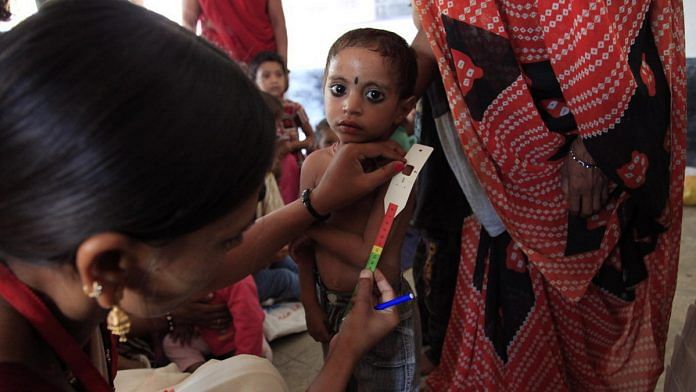New Delhi: Improving education among women, encouraging a diversified diet and providing easier access to healthcare are some of the ways in which India can achieve nutrition security by 2030, a report by the Indian Council for Research on International Relations (ICRIER) has said.
The report, published Wednesday, recognises “multi-dimensional determinants” of malnutrition and decodes the links between nutrition, income, poverty, food security and agriculture.
To identify what leads to malnutrition in India, the report ran logistic regressions — a mathematical model that determines the probability of an event — for children under five years of age who were underweight, stunted and wasted (suffered from acute malnutrition).
“Mother’s education, particularly higher education, and wealth index show a strong association with malnutrition indicators,” the report notes.
It adds that factors like duration of breastfeeding, healthcare interventions like taking iron-folic acid, supplements, antenatal care, place of delivery and caste also had a significant impact in decreasing child malnutrition.
“The study finds that mortality and nutritional security are closely interlinked with several of the multi-sectoral solutions to address child malnutrition such as breastfeeding practices, wealth index and mother’s educational status have a significant impact on child mortality,” the report says.
The 105-page report has been authored by ICRIER Research Fellow Shyma Jose, Infosys Chair Professor for Agriculture ICRIER Ashok Gulati and Kriti Khurana, a research assistant.
Also read: Fighting malnutrition is a Modi govt priority, but 2 ministries don’t agree on funding
India lags behind in eradicating malnutrition
Ending malnutrition, along with eradicating poverty and reducing child mortality, is part of the UN’s Sustainable Development Goals (SDG) — a set of 17 global goals that were adopted by member countries in 2015 to encourage sustainable development by 2030.
However, the report finds that while India is “on track” to achieve the SDG targets of ending poverty and reducing neonatal and child mortality, it “seems to lag far behind” in reducing the proportion of children who are underweight, stunted and wasted under five years of age by 2030.
Wasting refers to a child who is too thin for his or her height — result of recent rapid weight loss or failure to gain weight.
The authors of the ICRIER report recommend four key methods that policymakers need to focus on to achieve nutritional security.
First, the report suggests, agricultural policies must be leveraged to make them more ‘nutrition sensitive’, and diversified diet must be reinforced for the nutritional development of children.
Second, policies must ensure that food-based safety nets must provide a “diversified food basket”.
Third, there must be an easier access to health care and prenatal care facilities with an added attention to sanitation and drinking water facilities.
According to the fourth suggestion in the report, liberal scholarships must be provided for the education of women, especially for higher education.
In 2016-18, there were over 809.9 million undernourished people across the world, out of which 194.4 million (24 per cent) were Indians.
India also accounted for 30.9 per cent of the world’s stunted children under five years of age and 50.9 per cent of world’s wasted children in 2016-18.
The ICRIER report also cites a Brookings study that has projected that India will account for 33 per cent of the world’s stunted children under 5 years of age and 21 per cent of wasted children worldwide by 2030 “unless stringent actions are taken”.
Also read: Modi’s POSHAN Abhiyan unlikely to make India malnutrition-free by 2022: CSE report



